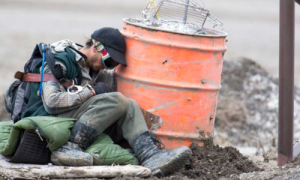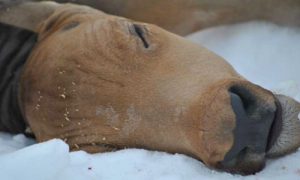Yellowstone Announces End to 2014 Bison Slaughter Following One-Man Blockade
ACTIVISM, 17 Mar 2014
Buffalo Field Campaign, EcoWatch – TRANSCEND Media Service
Comfrey Jacobs appeared in U.S. federal court today for his first arraignment after being arrested for blocking the road to Yellowstone National Park’s bison trap on March 6.

Jacobs blocked the road before more wild bison could be loaded onto trailers destined for slaughter facilities. Jacobs handcuffed himself to a hunter orange 55-gallon barrel filled with concrete, and wire-mesh webbing spanning the entrance to the roadway.
Photo credit: Deby Dixon/ BFC
Jacobs was charged with three offenses: disorderly conduct, breaking a closure and interfering with a government operation. He was offered a plea bargain: if he plead guilty he would be charged $1,000 in restitution, be placed on unsupervised probation for five year and be banned from Yellowstone National Park for five years.
Jacobs did not accept the plea bargain, as he is awaiting further legal counsel. There will be a continuation of his arraignment on April 2. If Jacobs chooses to go to trial, he will be tried by a judge and not a jury of his peers.
The goal of Comfrey’s decision to block access to Yellowstone’s bison trap was to prevent more of America’s last wild, migratory bison from being shipped to slaughter. Jacobs stalled slaughter operations for more than two hours.
Comfrey’s action demonstrated strong public opposition to the buffalo slaughter and has drawn an incredible amount of media and public attention to the issue. The day following Jacob’s blockade, Yellowstone National Park issued their only press release for this year’s controversial bison operations, announcing that the Stephens Creek bison trap was empty and Yellowstone had no further plans to capture this season.
“My action raised enough public awareness that Yellowstone announced a cease to their operations the following day,” Jacobs said.
This was the first time a citizen exercised civil disobedience at Yellowstone’s Stephens Creek bison trap. Yellowstone National Park initiates a seven-mile public access closure surrounding their Stephens Creek bison trap while highly controversial bison management activities are underway. Members of Buffalo Field Campaign (BFC) were present to document and lend support.
Comfrey told Buffalo Field Campaign, “I have no regrets. I accept all the consequences of my actions and hope it raises awareness on this issue.”
Since Feb. 7, approximately 450 wild buffalo have been captured in Yellowstone National Park’s Stephens Creek bison trap, located in the Gardiner Basin. 318 were shipped to slaughter or research facilities and some were released. Additionally, more than 270 wild bison have been killed by state and treaty hunters just outside Yellowstone’s boundary in Montana.

Perfectly formed and only six weeks away from being born, a buffalo calf, still attached to the womb, is discarded in his mother’s gut pile. Adult female buffalo are taking the brunt of the killing through hunting and slaughter.
Photo credit: Stephany Seay/ BFC
Through hunting, slaughter and consignment to research, more than 600 of America’s last wild, migratory bison have been eliminated this year, marking a decimation of the world’s most significant bison herds.
“Comfrey Jacobs is a hero,” said BFC’s Executive Director Dan Brister. “His actions speak for thousands of people who are upset by the slaughter of America’s last wild buffalo.”
Yellowstone and its partners in the Interagency Bison Management Plan (IBMP) have set an arbitrary population target of 3,000-3,500 bison, yet a Yellowstone bison carrying capacity study has determined that the Park can sustain upwards of 6,200 wild bison. Additionally, there are tens of thousands of acres of public lands surrounding Yellowstone that could sustain thousands more.
“The IBMP’s population target is totally driven by politics with no basis in science,” said Stephany Seay, a BFC spokesperson. “Wild American bison are ecologically extinct throughout their native range, and while they have no federal protections they certainly warrant Endangered Species Act protections.”
The zero-tolerance bison politics of Montana’s livestock industry are driving the policies that are pushing these significant herds back to the brink of extinction.
To speak out against the IBMP’s slaughter visit the Buffalo Field Campaign’s page and take action.
DISCLAIMER: The statements, views and opinions expressed in pieces republished here are solely those of the authors and do not necessarily represent those of TMS. In accordance with title 17 U.S.C. section 107, this material is distributed without profit to those who have expressed a prior interest in receiving the included information for research and educational purposes. TMS has no affiliation whatsoever with the originator of this article nor is TMS endorsed or sponsored by the originator. “GO TO ORIGINAL” links are provided as a convenience to our readers and allow for verification of authenticity. However, as originating pages are often updated by their originating host sites, the versions posted may not match the versions our readers view when clicking the “GO TO ORIGINAL” links. This site contains copyrighted material the use of which has not always been specifically authorized by the copyright owner. We are making such material available in our efforts to advance understanding of environmental, political, human rights, economic, democracy, scientific, and social justice issues, etc. We believe this constitutes a ‘fair use’ of any such copyrighted material as provided for in section 107 of the US Copyright Law. In accordance with Title 17 U.S.C. Section 107, the material on this site is distributed without profit to those who have expressed a prior interest in receiving the included information for research and educational purposes. For more information go to: http://www.law.cornell.edu/uscode/17/107.shtml. If you wish to use copyrighted material from this site for purposes of your own that go beyond ‘fair use’, you must obtain permission from the copyright owner.